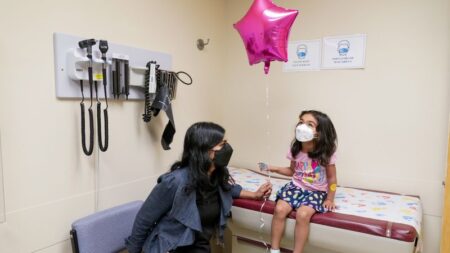As recent reports indicate, the United States is facing a significant measles outbreak, with half of the states now documenting cases. The national total has surpassed 800 cases in the current year alone, as noted by a comprehensive tally from CNN. This resurgence of measles has raised alarms among healthcare professionals and public health officials alike, who are mobilizing to confront the alarming rise in infections.
Most of the reported cases are clustered around a multistate outbreak affecting Texas, New Mexico, Oklahoma, and potentially Kansas. According to updates from state health departments, the outbreak had reached a staggering 709 cases by Friday. The breakdown reveals that Texas has the highest number of reported cases, accounting for 597. New Mexico follows with 63 cases, and Oklahoma has identified 12 cases — comprising nine confirmed instances and three classified as probable by the end of last week. Interestingly, case numbers in both New Mexico and Oklahoma have remained unchanged since the previous Tuesday, suggesting that the outbreak may be stabilizing in those areas.
In Kansas, health officials report 37 cases that appear to be associated with this larger multistate outbreak. Experts have expressed concern that the official count may be a gross underestimation since numerous cases go unreported. This raises serious implications for public health, as undetected infections could facilitate further transmission of the virus.
The outbreak has had grave consequences, resulting in 69 hospitalizations across Texas, New Mexico, and Kansas as a direct result of the outbreak. This figure reflects an increase of five new hospitalizations compared to previous reports. In a broader scope, the US Centers for Disease Control and Prevention (CDC) has confirmed at least 85 hospitalizations nationwide, representing 11% of the overall confirmed cases. Alarmingly, only 3% of this year’s cases have been reported among individuals who received either one or two doses of the measles-mumps-rubella (MMR) vaccine, underscoring the vaccine’s efficacy in preventing the disease.
Local health authorities are actively working to boost vaccination rates, particularly in communities with low immunization coverage. For instance, clinics in Lubbock, Texas—a city near the outbreak’s epicenter—have expanded their operating hours to facilitate increased vaccination. Katherine Wells, the director of Lubbock Public Health, reported that these clinics have administered 450 additional doses of the MMR vaccine compared to the usual quantity expected by this point in the year. It is noteworthy that two doses of the MMR vaccine are shown to be 97% effective against the measles virus, highlighting the importance of immunization efforts in curtailing this outbreak.
Despite the success of vaccination campaigns in the past—where measles was declared eliminated in the United States in 2000—experts are warning that the growing number of cases could jeopardize this status. Dr. David Sugerman, a senior scientist at the CDC, stated that the situation could lead to the re-establishment of endemic measles if the current trend continues unchecked. He mentioned that potential jeopardizing factors could crystallize after twelve months of ongoing virus circulation, estimating a critical point around January 20, 2026.
The human toll of this outbreak has already been tragic, with two children in Texas succumbing to the virus, and a third death in New Mexico currently under investigation. All of these children were unvaccinated, further emphasizing the need for vaccination. In a broader context, the World Health Organization has observed correlated cases in Mexico along with investigations of cases in Colorado and Pennsylvania that may trace back to the Texas outbreak. The Arkansas health department also noted a measles case triggered by out-of-state travel, indicating the interconnected nature of these public health concerns.
In summary, the current measles outbreak in the United States presents a multifaceted challenge, necessitating a concerted effort by health officials, communities, and individuals to prioritize vaccination and control the spread of this potentially fatal disease. It serves as a stark reminder of the importance of maintaining high immunization rates to protect vulnerable populations and ensure public health safety across the nation.












